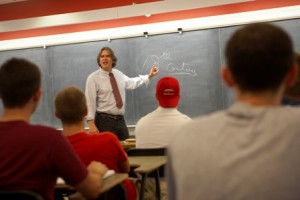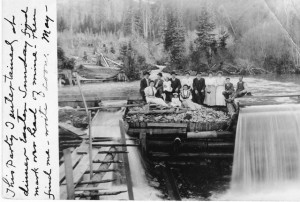
Professor D.C. Jackson teaches a class in Ramer History House.
D.C. Jackson likes to bring the unexpected into his classroom. Ask most people about their idea of technology, says the professor of history, and they’ll proudly hold out their iPhone or some other gadget. But it’s technology in another sense – water, power, and electric networks – where Jackson demonstrates the way of the world to his students.
“It really shows how the world works, how we control water, who uses it, how it gets used,” explains Jackson. “We just take for granted that we turn on the tap and get water we can drink, or flip on the switch and the lights come on and the Xbox fires up. That’s a very first-world assumption. What in many ways separates the first world from the developing world is this type of thing: sanitary, bountiful water and electric power on demand.”
Technology doesn’t exist in a vacuum; it encompasses important social, economic, and political dimensions that guide its development and implementation. The complexity of understanding how critical infrastructure projects are built and grow is one of the most intriguing parts of the equation for Jackson.
“We like to think of technology and science as being apolitical, but politics is a big part of it – not necessarily politics in a negative sense, but politics as a reflection of how society makes decisions about important issues,” he explains. “That’s just how it works.”
Something as seemingly simple as a dam can have huge ramifications, a lesson Jackson strives to convey to his students. He doesn’t expect all of them to passionately pursue graduate degrees in history after taking one of his classes, but he does expect them to dig below the surface and question easy assumptions no matter where life takes them after Lafayette.
“Things aren’t always what they seem. You can’t live your life believing everything you ever read in newspapers, blogs, and Twitter feeds,” he says. “Few students coming to Lafayette think, ‘Yeah, dam history is where it’s at!’ and I don’t expect students to want to become ‘dam historians’ – pun intended! But I do hope they come to appreciate that something as seemingly mundane as dam history and the way societies control water actually have tremendous relevance in the modern world.”
Fresh off a bachelor’s degree in engineering from Swarthmore College, Jackson didn’t see history as an obvious career path. He began by working with the National Park Service, which is where his fascination with the history of dams and waterways began. Realizing that a lifetime in the park service wasn’t his ultimate goal, he returned to graduate school after six years and earned a master’s degree and Ph.D. in American civilization from the University of Pennsylvania. This led to another realization.

An 1908 postcard showing a dam in Mullen Idaho, which will appear in Jackson's upcoming book.
“When I went back to grad school, I appreciated the academic environment and the opportunities it offered in exploring important ideas. I also discovered the classroom – with the give-and-take of learning – to be a place I really loved. I realized that teaching was something I wanted to do,” he says. “I got to teach some courses on my own at Penn and really enjoyed it. I knew a job at a college like Lafayette was something I would love to do, a place where I could experience the joys of the classroom while also carrying on my research.”
Some of that research has been 30 years in the making. Next year the University of Pittsburgh Press is scheduled to publish his book Pastoral and Monumental: Dams, Postcards, and the American Landscape. An avid collector of dam- and water-related postcards dating back to his days with the park service, Jackson’s forthcoming book draws upon his expansive collection to show how dams have contributed to the fabric of American life. The postcards provide a snapshot of what life was like in the late 19th-early 20th century United States, a time when postcards were produced in enormous quantities and featured a huge variety of scenes.
“Postcards provide interesting ways of discovering how people viewed their environment,” he explains. “’Landscape’ in the title refers to the physical landscape as well as the cultural landscape. We can trace the history of dams through postcards because they provide a comprehensive sense of how dams were part of American life. They describe disasters, construction views, and all the different ways dams are used, whether it’s logging, navigation, irrigation, municipal water supply, hydroelectric power, or flood control. Each one of these postcards reflects a different facet of a huge and important story involving dams and water-control technology.”
Jackson has appeared as an on-camera expert about dams on the History Channel program Modern Marvels and in an episode of the acclaimed five-part PBS miniseries Building Big. He also was recently interviewed for the PBS series American Experience as an expert on the Grand Coulee Dam. His most recent book, co-authored with David Billington, is Big Dams of the New Deal Era: A Confluence of Engineering and Politics.
Last year, he delivered the keynote address at the Hoover Dam 75th Anniversary Celebration in Las Vegas, Nev. He also received the Overseas Prize, an international honor from the Institution of Civil Engineering, given for the best paper published in one of the institution’s numerous academic journals that focuses on a topic outside the British Isles. Jackson’s article, “Structural Art: John S. Eastwood and the Multiple Arch Dam,” appeared in the August 2009 volume of Proceedings of the ICE – Engineering History and Heritage.


3 Comments
Derek:
Nice to hear from you and thanks for the kind and thoughtful comments! I trust things are going well and life is good. What are you up to these days? Keep me posted!
All the best,
DC
Prof. Jackson’s ‘History of Technology’ course was an incredible experience at Lafayette. The most impressive section to me was mining/raw materials. As Prof. Jackson describes above, the developed world takes ‘sanitary, bountiful water and electric power on demand’ for granted, but moreover we rarely recognize how mining not only affects what we use or consume each and every day – not to mention how it shaped expansion of America’s fledgling nation during the era of ‘Manifest Destiny’. That course really tied together my passions and eventual majors for me at Lafayette – geology and history. Lafayette is blessed with a very engaging (and funny!), interesting, and intellectual history department. I still love seeing members of the department on the History Channel!
Comments are closed.